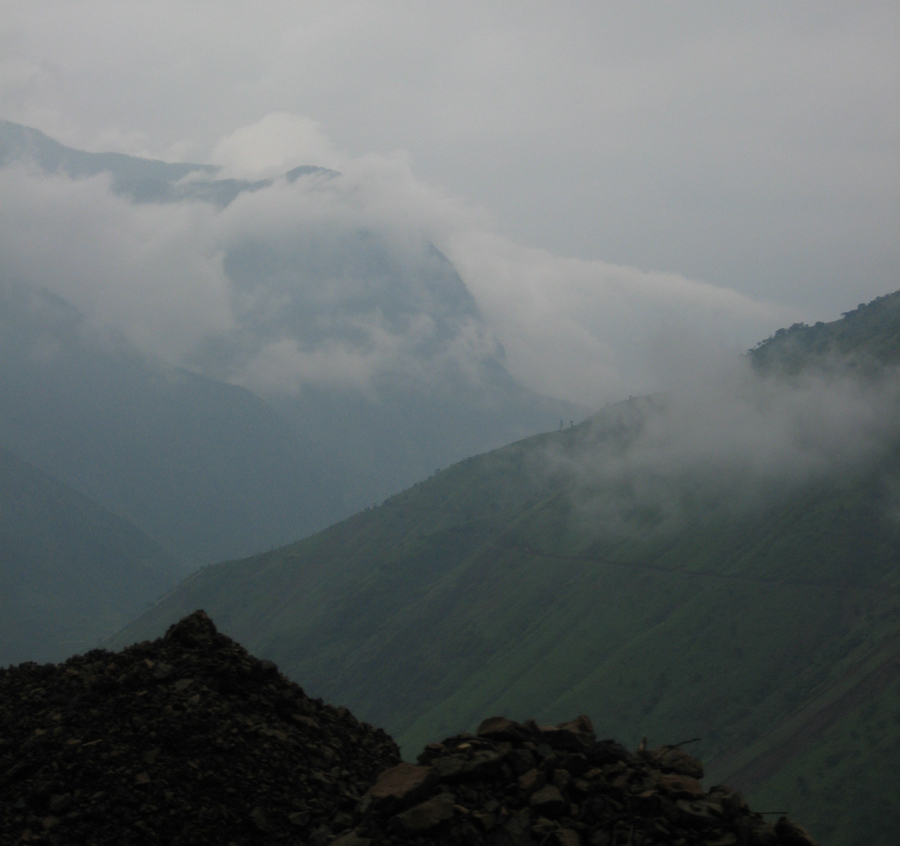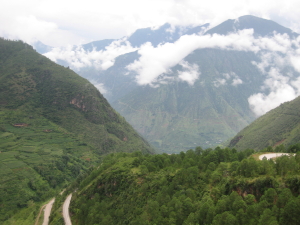 __
__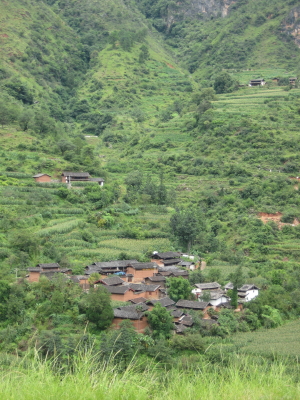 __
__
Return to China, 2008 -- Part IV: To Lugu Lake and Mosuo Country
We drop Fei Bao at the Lijiang Airport (he's going back to work
in Kunming) and head north into the foothills of the Himalayas. Li Jia says
that this will be the "best" part of our trip. After her "surprise"
on Lake Erhai we believe her!
 __
__ __
__
Amy and Lily take turns driving -- carefully!
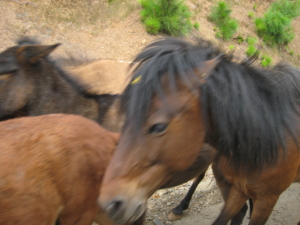 __
__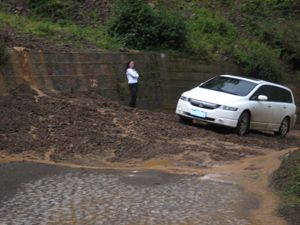 __
__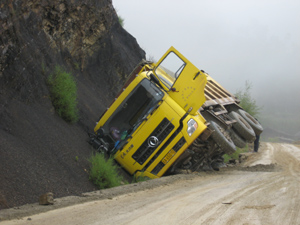
We cross the Yangtze River and look with amazement at the construction of a new train line or highway which runs straight into a moutainside, -- i.e., no tunnel, YET. The journey will probably be a lot faster the next time we come.
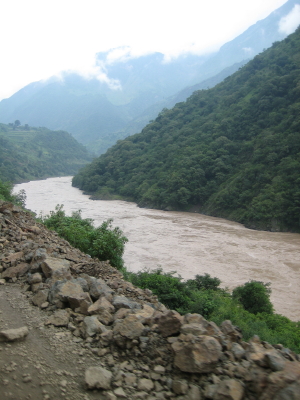 __
__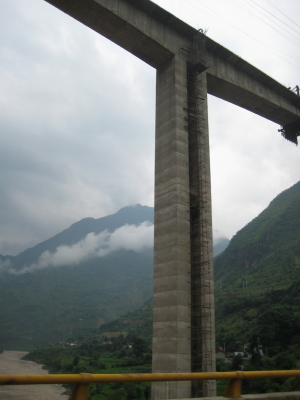 __
__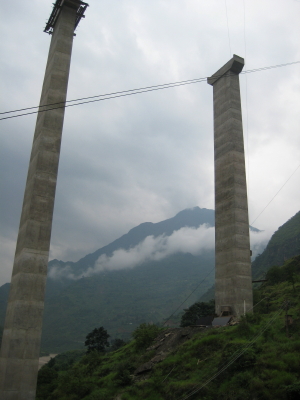
After eight hours of the most amazing drive of our lives, we round a curve, and there before us is Lugu Lake!
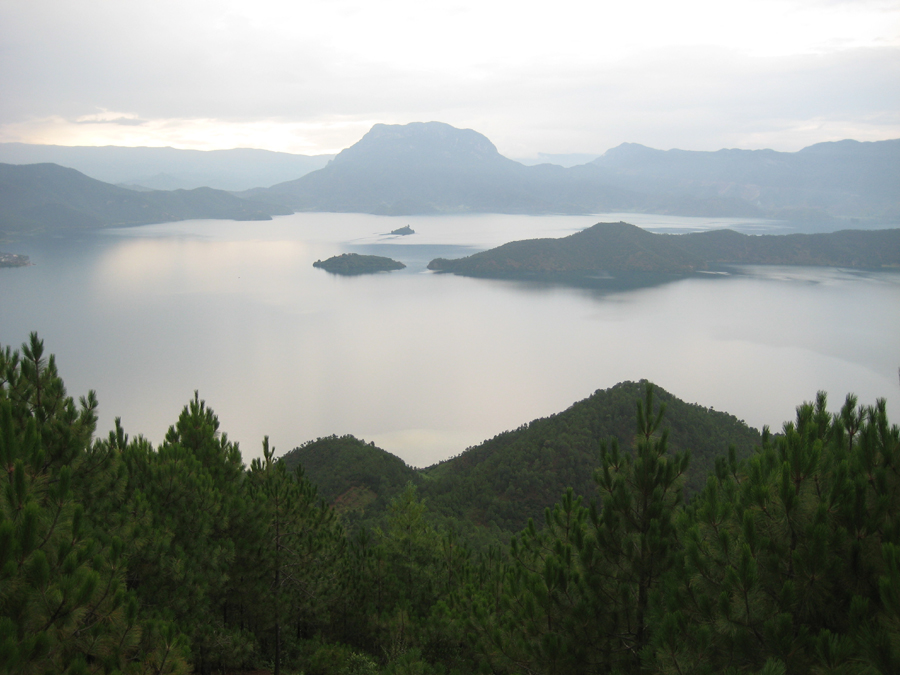
"Lugu Lake, or Xienumi (meaning "Mother Lake" in Mosuo), lies at an elevation of 8,825 ft. The lake straddles the boundary between Ninglang County, Yunnan Province and Yanyuan County, Sichuan Province. It has an average depth of nearly 150 ft, while its deepest point is a gasping 305 ft. The lake contains 6.4 billion cubic feet of water, constituting it as the 3rd largest deep-water lake in China. It has 18 bays, 17 beaches, 5 major islands, 2 peninsulas, and an embankment island. Lugu Lake has no input streams, but is only fed by a spring near Xiao Luoshui in Sichuan making it a crystal clear lake allowing you to see almost 40 ft down into the water ... sometimes it is impossible to distinguish it from the blue sky. The water flows out at the marshy area of Caohai, flowing into the Gaizu River, and then into the Yulong River, and finally into the mighty Yangtze River which empties into the Pacific Ocean at Shanghai." The lake is lined with villages all along its banks. The Mosuo People, as they are now officially called (though still under classification as the Naxi nationality in Yunnan and the Mongol nationality in Sichuan), make up the majority of the population around the lake. Other nationalities include the Pumi, Lisu, Yi, Tibetan, Naxi, and an increasing amount of Han." (From the college senior thesis of Jesse Millett, 2006)
We now circle around the lake and down the moutain to our destination -- the Mosuo village of Lige.
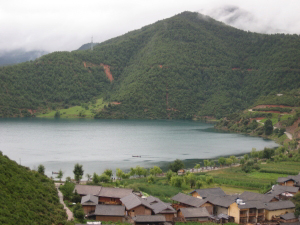 __
__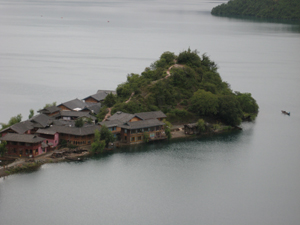 __
__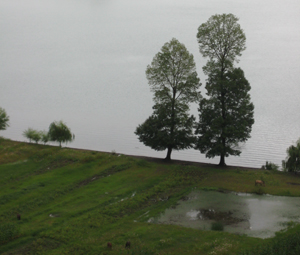
In Lige
we are met by our Mosuo family -- below (left) Amy, Li Jia and Ama, the family
Matriarch; below (right) Er Cha
Na Mu (sister #4; she runs a youth hostel and is the community leader), Da Shi
La Cuo (sister #1; she keeps crops and animals and her husband guides boat rides),
Kim (Hui Lan - is her Chinese name), Li Yan (Li Jia's sister; Amy is her English
name), Gao Zu La Mu (sister #3; she runs a gift shop), and Li Jia.
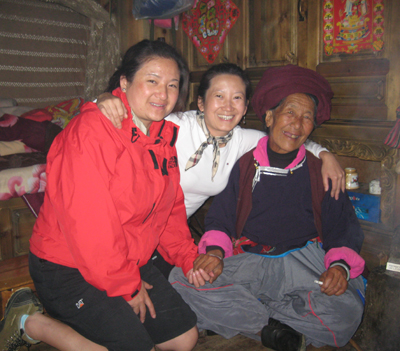 __
__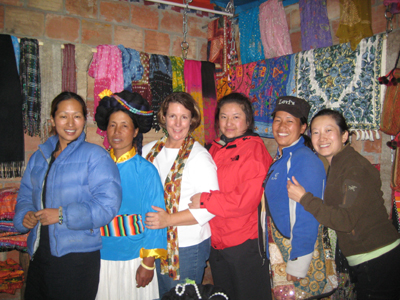
To explain how we happen to have Mosuo "family" in Lige we have to take two backward time travels. First we go to 1993 when our adventurous friends, Jin Fei Bao and Li Jia drive one of the first vehicles to Lugu Lake and certainly the first vehicle ever seen by the local people with a woman driving, namely Li Jia. A woman driving! This is a good sign in this matriarchial culture and Fei Bao and Li Jia become known to all of the villagers and make fast friends with the Mu family, headed by Ama with her four daughters. At this time the village had no electricity and very little contact with the outside world.
Fei Bao and Li Jia return to Kunming and carry on with their lives but in 1995 Li Jia has a stong "feeling" that she must return to the village. She returns to find the village in mourning because sister # 2 of the Mu family has died. Li Jia stays with the family through the mourning process and during this time is adopted into the family. Since that time she has kept in very close contact with her Mosuo family. Below are three photographs from 1993.
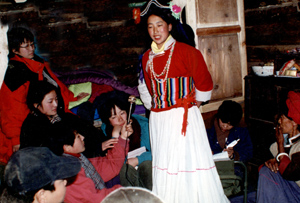 __
__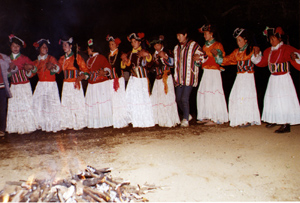 __
__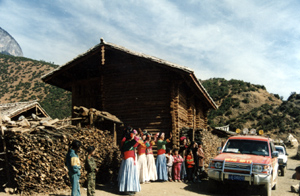
The second time travel back goes to 2004. Following the trade winds of the successful exhibition of Dr. Clinton Millett's 1945 photographs in Kunming, Dr. Millett's 20-year old grandson, Jesse Millett, changes his plans to go to Columbia, South America and goes to explore China instead. He stays with Fei Bao and Li Jia for five months, begins his study of Chinese, helps prepare for a second exhibition of his grandfather's photographs and travels to Lige Village on Lugu Lake for one month during which time he lives with the Mu family.
Upon returning to the University of Colorado, Jesse changes his major to Chinese Studies and in 2006 he returns to Kunming for a semester abroad. During this semester he goes to Lige Village for more careful observation in preparation for writing his senior thesis -- "Lugu Lake: Preservation and Exploitation." Below are three photographs from 2006 -- Li Jia with Ama and two grandaughters, a pig roast in the countryside and Jesse Millett.
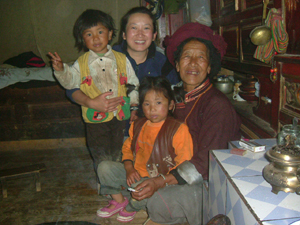 __
__ __
__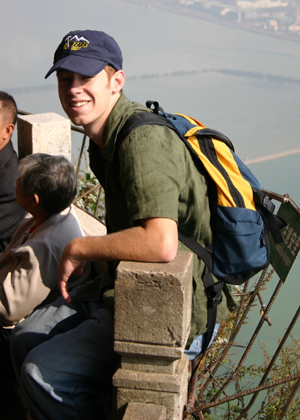
For a peek into this ancient culture we'll clip a few paragraphs from Jesse's insightful thesis:
The Mosuo are usually thought to just be located along the edges of Lugu Lake, but in fact they spread far into the mountains and their numbers are somewhere between 30,000 and 40,000 ... One of the most important characteristics of the Mosuo, especially from an anthropological perspective, is that they still hold a completely matrilineal society ... The marriage system, or lack of one, is the most unique part of Mosuo culture. It is the only living society in the world that has such a practice. The Mosuo people have no legal marriage bond. Instead, they have what in Chinese is called zuohun, which literally translates as "walking marriage"; however, it can also be referred to as "visiting marriage." In the Mosuo language it is called azhu sese, or "a friend who comes and goes." When a Mosuo girl has matured, at around 13 years of age, the village considers her a woman who is fit to receive visitors. This does not mean that she will receive lovers right away, and in actuality, most women don't start relationships until they are in their late teens or early twenties. Once a woman has found someone of interest, she will, in one way or another, signal her lover to come visit her late that night ... Once the lover has been invited, he will sneak up to the woman's bedroom late at night, where they will stay warm by the small fire in her room and get to know each other better. The man will spend the night there, but will leave early in the morning, preferably before the sun rises but absolutely before anyone else in the house is awake. It is a disgrace if he is seen, for discussing sexual matters within the household is unthinkable. The man then returns to his mother's house for the day, only to return to his lover's the next night ... These relationships will last as long as the couple wants, and sometimes will last for life, as long as love is still persistent. When the relationship begins to fade away, the man will just stop visiting, or the woman will place his things outside her door as a signal for him to never visit again ... If a child is born through one of these relationships, the father holds no obligation to the child. The mother and the mother's family raise the child. In fact, raising a child is the entire family's responsibility, where everybody takes equal share in the child's upbringing. It is not uncommon to see the child's aunt breastfeeding him ... The father's responsibility lies within his mother's home and his sister's children ...
To read a lot more on the Mosuo culture, how it is changing, the effects of tourism and links to other sources of information go to: Lugu Lake: Preservation and Exploitation by Jesse Millett.
While Jesse was in Mosuo Land for two, one-month periods, we are here for only three days. We check into our hotel/hostel run by sister # 4, Er Cha; our rooms are beautiful, overlooking a courtyard on one side and a balcony with a view of Lake Lugu on the other. Satellite TV is everywhere, so we can enjoy the Olympics every day. We have a wonderful dinner and Gregg joins Ama for an evening smoke.
 __
__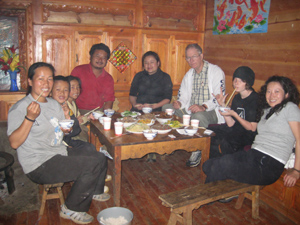 __
__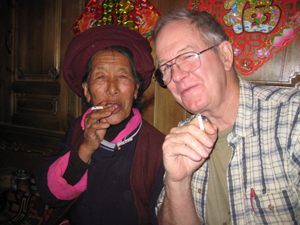
In the morning we start our explorations of the area. It rained hard all night long which made our first stop at a washout which takes about an hour to repair. We slog on to the Mosuo village of Yong Ning where we eat cold bean curd soup in the market place and visit the home of Siobhan and Peter Mattison. Siobhan is doing her doctoral thesis on the Mosuo culture and Peter is taking a year off, helping his wife and writing. Together they trek far into the mountains making systematic interviews. We're looking forward to comparing Siobhan's findings with Jesse's. On the way back we visit a functioning 600-year old Tibetan Buddhist temple. Amy, Li Jia and Er Cha offer ritualized respect at various alters and leave money at the offering plate.
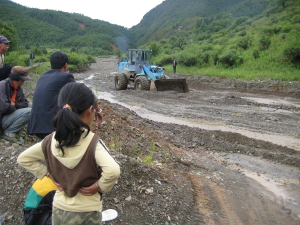 __
__ __
__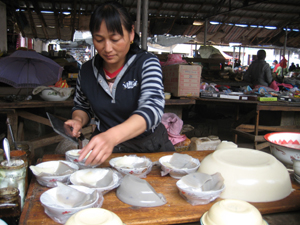
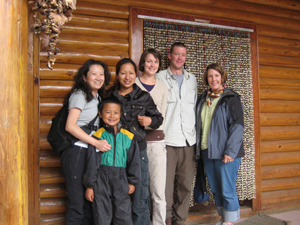 __
__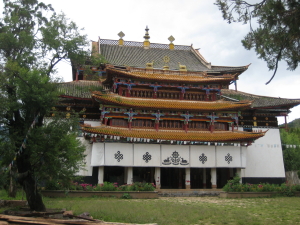 __
__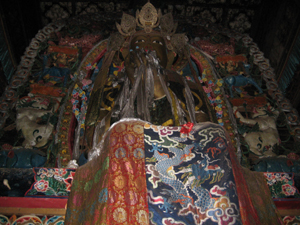
We continue our journey enjoying the sights and friendship.
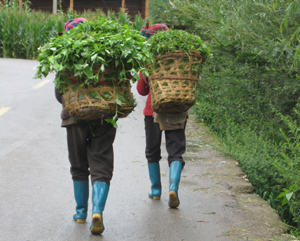 __
__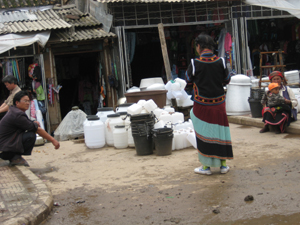 __
__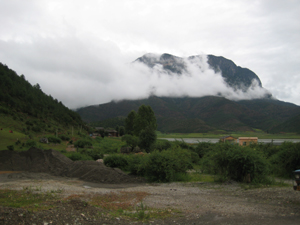
 __
__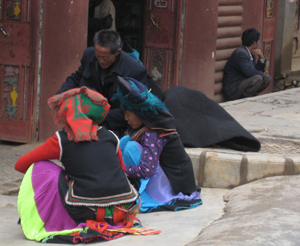 __
__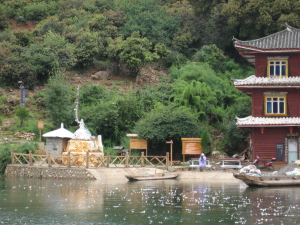
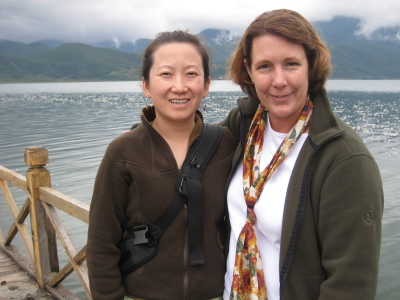 __
__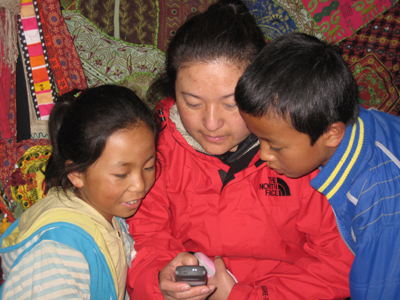
During our 3-day visit we had dinner at each of the three sister's homes, the main home being the hotel/hostel with Ama's traditional room at the back. In his thesis Jesse describes this room as follows: "The most important room in the house is called in Mosuo the rimi, or the mother's home. This room traditionally has no windows, but only a small doorway. This is where the old men and women sleep, as well as children under thirteen. Sometimes the kitchen is even inside the rimi, but the most central item in the room is definitely the fire pit. The fire here is almost always burning and meals are usually eaten around it, and sometimes cooked over it. The dabu, or woman of the house, is the one who tends to the fire and makes the frequent sacrifices to the altar, which stands behind the fire pit. The altar usually has various items on it but almost always includes a Buddhist picture or figurine such as the Dalai Lama or the Buddha himself. Other items might include pictures of deceased ancestors, or of Daba idols. Daba is the local Mosuo religion. Ironically, on every altar there exists some sort of memorial of Mao Zedong, as if he actually helped and liberated the Mosuo people." Indeed this is Ama's special room, where she spends most of her time, with her bed right next to the indoor-fire and alter. However the cooking is now done in the hotel kitchen with most family members eating in the hotel dinning room.
But wait, "we had dinner at each of the three sister's homes." How can that be? Li Jia explains: "Money changes everything. Each household is allowed one paid performer at the nightly community dance, so to qualify the two sisters moved from the hotel/hostel traditional home and built their own homes. Now each of the three households has a dancer!"
 __
__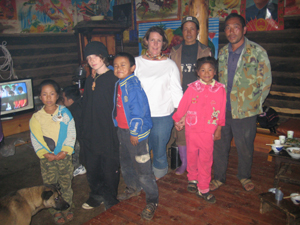 __
__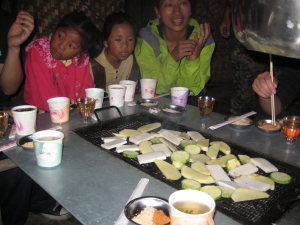
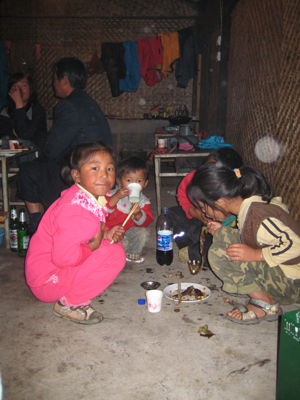 __
__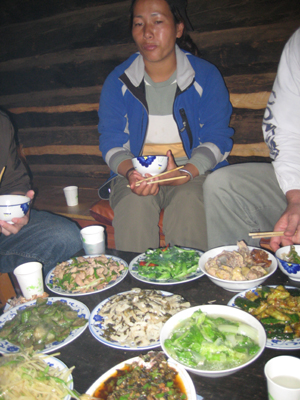 __
__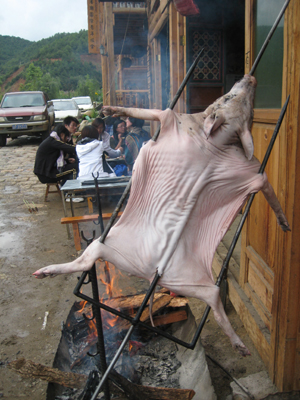
We have so many new friends in Lige village. Devin enjoys soccer
with the village kids. He has really connected with the Mosuo people and the
Mosou way of life. Gregg and Kim take scenic walks around the village and chat
with tourists. One tourist named Harry Kim, an American Ph.D student who had
been studying bird flu in Beijing, joined us for dinner one night. The change
that 15 years has brought to the village and the Mosou people is remarkable.
The village is now a remote tourist destination for those who have the desire
to get there. It is well worth the trip with a choice of accommodating youth
hostels, bars and restaurants. The villagers also generate income through guided
boat rides on the lake and nightly village folk dances.
 __
__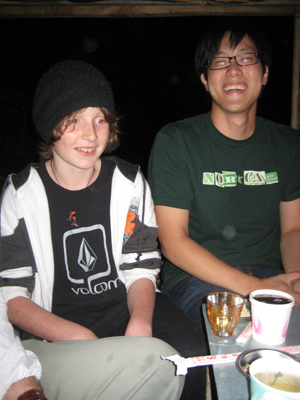 __
__
Now for the Lugu Lake/Mosuo finale. We've attended two of the evening dances as tourist/visitors but tonight preparations are underway. Devin is being outfitted; Li Jia is dressing; Li Jia's sisters, her Ama, her nieces (Joshema and Aham), nephew (Chang Chang ) and adopted son (Jaba) -- everyone is getting ready for tonight because Devin has agreed to go in Mosuo dress.
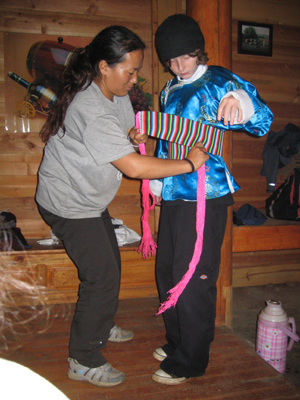 __
__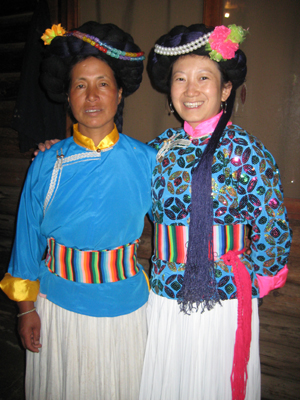 __
__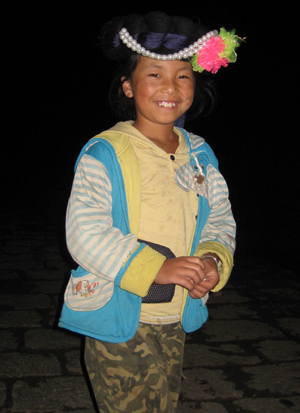
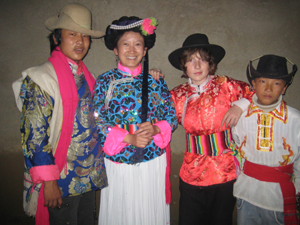 __
__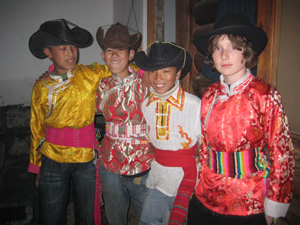 __
__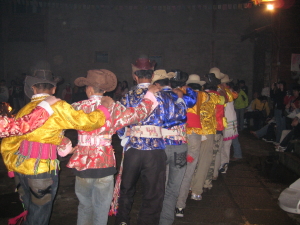
After the dance everyone said that Devin is now a Mosuo man!
Just look at that pose and look at those eyes!
 __
__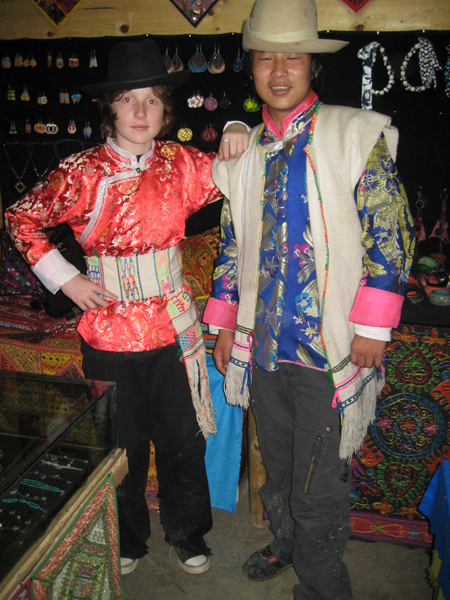
We feel joy and sadness as we leave Lige village on Lugu Lake. Gregg has become Apu (grandpa), Kim has found 3 new sisters, and Devin has become a Mosou man! It's a rainy, foggy morning as we say goodbye to our family and friends and start our long drive back to Kunming for the final few days of our amazing adventure in China.
